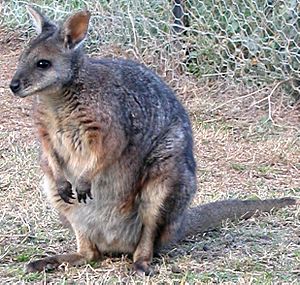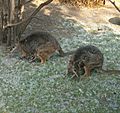Tammar wallaby facts for kids
Quick facts for kids Tammar wallaby |
|
|---|---|
 |
|
| Conservation status | |
| Scientific classification | |
| Kingdom: | |
| Phylum: | |
| Class: | |
| Infraclass: | |
| Order: | |
| Family: | |
| Genus: | |
| Binomial name | |
| Macropus eugenii Desmarest, 1817
|
|
The tammar wallaby (Macropus eugenii) are a small species of wallaby from Australia. They were the first macropods to be seen by Europeans. Francisco Pelsaert, captain of the Batavia, saw them when the ship was wrecked on the Abrolhos Islands in 1629. He said they looked like hopping cats. There are three sub-species of tammar wallaby:
- M. e. eugenii from mainland South Australia.
- M. e. derbianus from Western Australia.
- M. e. decres, the darma or dama wallaby, from Kangaroo Island, South Australia.
The name tammar comes from the word tamma, meaning sheoak. The wallaby lives under sheoak plants.
Tammar wallabies became extinct on mainland South Australia in the 1930's. Extinction has been caused by habitat destruction, hunting, and foxes. In 1998 a small population of South Australian wallabies was found living on Kawau Island near Auckland, in New Zealand. This group had been established by former South Australian governor, Sir George Grey in 1862 as part of his own private zoo. In New Zealand these wallabies were seen as a pest, and scientists have been studying ways to get rid of them. 85 wallabies were taken back to South Australia. After extensive fox controls at Innes National Park, 10 wallabies were released in November 2004. Another 36 were released in June 2005. These first releases were tracked with radio collars. Another group has been put into a captive breeding program at Monarto Zoo.
Tammar wallabies live in thick scrub during the day and come out into grassland to feed at night. They eat mainly grass and herbs. In dry areas they have been known to survive by drinking seawater. They range over an area of about 5 hectares (12 acres).
They are about 50 centimetres (19.7 in) in height, with a dark grey brown fur. They have reddish colour on their arms and sides, with pale grey fur on their bellies. They may also have a feint white line on their cheeks.
The wallabies have a very unusual breeding pattern. The fertilized eggs remain dormant inside the mother until the summer solstice when foetal development restarts. This is called "embryonic diapause". All the young are born on the same day about 31 days later, at the end of January or the beginning of February.
The tammar wallaby is the marsupial chosen for the genome sequencing project. Scientists are studying the milk from the wallaby as they think it might contain a new and powerful antibiotic.
Images for kids
-
A drawing of two tammar wallabies by John Gould (1863)
-
A tammar wallaby on North Island in the Houtman Abrolhos
See also
 In Spanish: Ualabí de Tammar para niños
In Spanish: Ualabí de Tammar para niños










